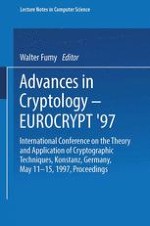1997 | OriginalPaper | Buchkapitel
Distributed “Magic Ink” Signatures
verfasst von : Markus Jakobsson, Moti Yung
Erschienen in: Advances in Cryptology — EUROCRYPT ’97
Verlag: Springer Berlin Heidelberg
Enthalten in: Professional Book Archive
Aktivieren Sie unsere intelligente Suche, um passende Fachinhalte oder Patente zu finden.
Wählen Sie Textabschnitte aus um mit Künstlicher Intelligenz passenden Patente zu finden. powered by
Markieren Sie Textabschnitte, um KI-gestützt weitere passende Inhalte zu finden. powered by
The physical analog of “blind signatures” of Chaum is a document and a carbon paper put into an envelope, allowing the signer to transfer his signature onto the document by signing on the envelope, and without opening it. Only the receiver can present the signed document while the signer cannot “unblind” its signature and get the document signed.When an authority signs “access tokens”, “electronic coins”, “credentials” or “passports”, it makes sense to assume that whereas the users can typically enjoy the disassociation of the blindly signed token and the token itself (i.e. anonymity and privacy), there may be cases which require “unblinding” of a signature by the signing authority itself (to establish what is known as “audit trail” and to “revoke anonymity” in case of criminal activity).This leads us to consider a new notion of signature with the following physical parallel: The signer places a piece of paper with a carbon paper on top in an envelope as before (but the document on the paper is not yet written). The receiver then writes the document on the envelope using magic ink, e.g., ink that is only visible after being “developed”. Due to the carbon copy, this results in the document being written in visible ink on the internal paper. Then, the signer signs the envelope (so its signature on the document is made available). The receiver gets the internal paper and the signer retains the envelope with the magic ink copy. Should the signer need to unblind the document, he can develop the magic ink and get the document copy on the envelope. Note that the signing is not blinded forever to the signer. We call this new type of signature a magic ink signature.We present an efficient method for distributively generating magic ink signatures, requiring a quorum of servers to produce a signature and a (possibly different) quorum to unblind a signature. The scheme is robust, and the unblinding is guaranteed to work even if a set of up to a threshold of signers refuses to cooperate, or actively cheats during either the signing or the unblinding protocol. We base our specific implementation on the DSS algorithm. Our construction demonstrates the extended power of distributed signing.
